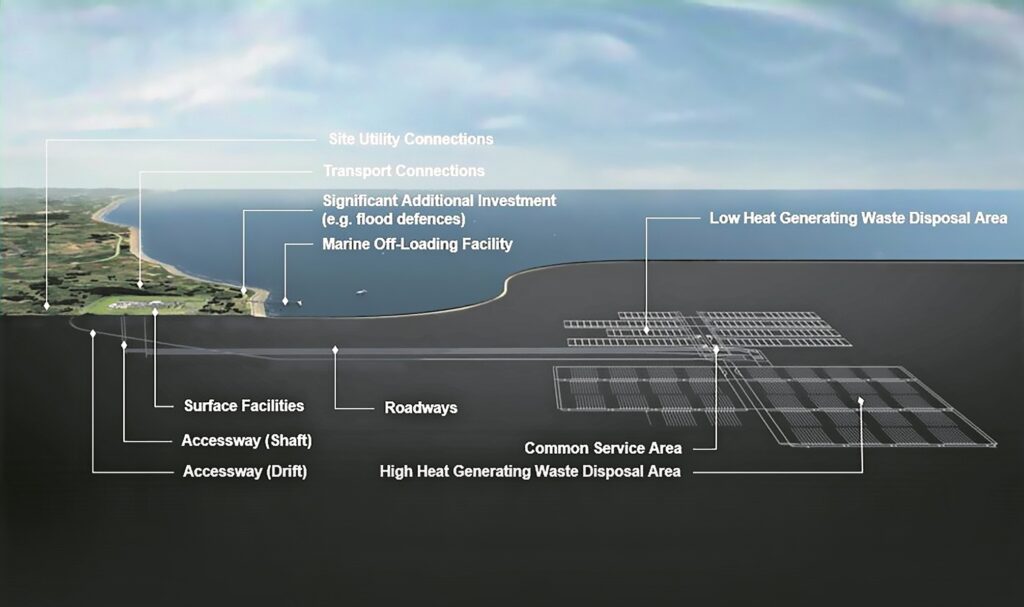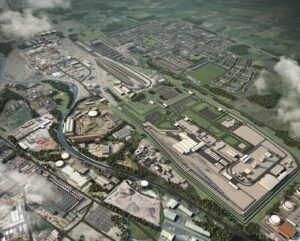What is a GDF and why is geological disposal the preferred solution?
Scientists and other authorities all over the world have agreed that geological disposal is the best long-term option to deal with higher activity radioactive waste – the most radioactive kind.
A Geological Disposal Facility (GDF) is infrastructure created to receive and safely and securely dispose of this type of waste, and it is designed to last and protect people and the environment for hundreds of thousands of years.
Waste will be safely disposed of up to 1,000metres underground. Geological disposal involves building a series of specially designed and engineered vaults and tunnels deep underground. The GDF facility could potentially be three times deeper than the height of the Shard in London, which is Britain’s tallest building.
Solid radioactive waste is packaged in secure engineered containers, typically made of metal or concrete, and then placed in a stable rock formation hundreds of metres below the surface, with the containers surrounded by clay or cement. This is called the multi-barrier approach. Once the waste is placed deep underground, the facility is then permanently sealed. It will not need any maintenance, and the radioactivity will decay away naturally.

Early Focus: Under the seabed, away from land
Discussions about the Theddlethorpe area have focused on a GDF deep in the rock beyond the coast. From a geological perspective, there is little difference between a GDF constructed within rocks under land or within rocks under the seabed. The depths of rock above ensures protection for many thousands of years. And while a GDF could be built hundreds of metres below the seabed, waste would not be disposed of on the seabed itself.
There are different challenges and considerations for the seabed than with a land-based GDF, such as avoiding disruption to marine environments during preliminary investigations and construction. The developers would also need to liaise with stakeholders in the fishing and maritime sectors.
The geology in the Theddlethorpe area
The rock around Theddlethorpe, including the area deep under the seabed, is made up of a well-known and predictable sequence of sedimentary rocks at the right depth for a GDF.
Jonathan Turner, Chief Geologist at Nuclear Waste Services (NWS), the developer of any potential GDF, said:
“For this area we could have a relatively uncomplicated ‘layer cake’ sequence of sedimentary rocks, with a number of clay-rich layers that have been identified by the BGS (British Geological Survey) as potential host rocks.
“Everything we know about this type of geology suggests that it extends uniformly for many kilometres. But it’s important to say that we don’t know anything like as much as we will need to know about the deep geology of Lincolnshire in order to understand whether it could be suitable for deep geological disposal.”
Facilities above ground
GDF surface facilities could require around one square kilometre of land, depending on how the site is laid out and if any of the facilities were off-site. These surface facilities would be linked to the larger underground GDF amenities by sloping tunnels and/or vertical shafts.
The primary purpose of the surface facilities would be to receive solid waste packages from a rail and road network and transfer them to the underground facilities, and to support ongoing construction of new underground vaults.
A return to nature
Under current plans, at the end of the operation phase the surface facility would be removed, with the area being restored to natural habitat. Independent regulators, including the Office for Nuclear Regulation (ONR) and the Environment Agency (EA), will review the designs and safety cases for a GDF, the proposed site, and the science, to make sure people and the environment are protected – during operation and for the long-term after closure.
A GDF will only be built if the regulators are completely satisfied. Choosing a suitable site for hosting a GDF requires the explicit consent of the local community. They must be willing to host the facility.


